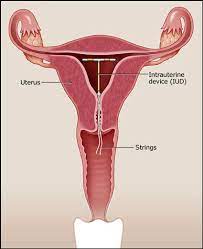
Most popular nonpermanent method of contraception used worldwide by 160 million, but only 2% of American women in 2002.
Two devices available in the U.S., one with a copper surface area and a levonorgestrel-releasing intrauterine system.
Highly effective in preventing pregnancy.
IUD insertion may be performed anytime during the menstrual cycle if pregnancy is excluded.
Copper IUD is the most effective form of emergency contraception with almost 100 perecent efficacy.
Copper IUD may be kept in place for up to 12 years.
Only 4.9% of women at risk of pregnancy use an IUD in the US in 2008.
Because such devices do not require active use, once they are inserted there is a very low failure rate, and their use increases the potential to reduce unintended pregnancies.
Heavier, longer, or more painful menses are associated with copper IUDs.
Copper device works primarily by prevention of fertilization by adverse effects on sperm.
Levonorgestrel releasing IUDs prevent fertilization through progestin effects on cervical mucus, and do not consistently suppress ovulation.
Rates of expulsion of intrauterine devices with cooper unit and levonorgestrel releasing system 1.8 and 2.9, respectively, per 100 years of use.
Levonorgestrel IUD maintain efficacy for at least seven years, with amenorrhea rates of up to 20% at 12 months and 40% of 24 months.
Complications include ectopic gestation, spontaneous abortion, pre-term delivery, bleeding, infection, pain, expulsion, and uterine perforation.
Serious complications are rare.
Incidence of uterine perforation and migration occurs in approximately 1-2 cases per 1000 insertions.
Perforation is often silent and noted following injury to other organs or by incidental imaging.
Risk of ectopic pregnancy 1 per 1000 person-years and is less than half the risk for women using no contraception.
IUDs inserted shortly after unprotected sex has a failure rate of less than one per thousand and is more effective than morning after pills and protecting from unwanted pregnancies.
A meta-analysis of 42 studies found a pregnancy rate of 0.09% among women using IUDs inserted from 2-10 days or more after unprotected intercourse,a rate 10-20 times better than that fanned with emergency contraception medications (Cleland K et al).
Current pregnancy, pelvic infection, endometrial or cervical cancer, a distorted uterine cavity are absolute contraindications, as is recent breast cancer.
Unintended pregnancy accounts for 36% of all pregnancies worldwide and nearly half of pregnancies in the US.
Prophylactic anabiotics are not necessary.
Screening for Chlamydia and Neisseria gonorrhea should be performed as part of screening guidelines.
Long acting reversible contraception by contraceptive implants or IUDs postpartum can facilitate contraception desires and have no effect on lactogenesis, breastmilk quantity, breast-feeding or infant growth.
